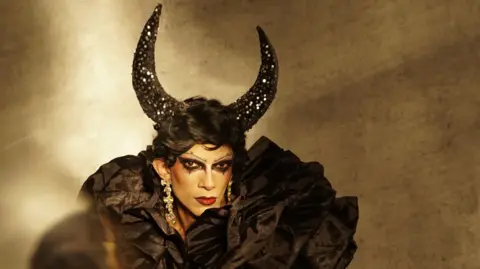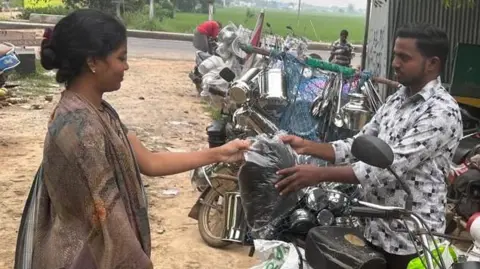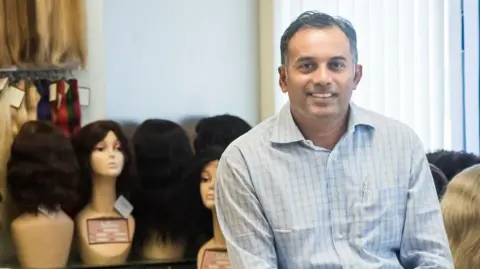Hair: 'It’s just thrown away but it's gold'
 Reemy
ReemyZeeshan Ali has been a drag artist for 10 years and has taken his show all over India.
Central to his performance is a collection of around 45 wigs.
“It’s an alter of identity, helping me transition from my everyday self into exaggerated, glamorous or whimsical characters. The right wig makes me feel more authentic and empowers me to command the stage," says Ali, who is based in Mumbai.
But getting that look right wasn't easy in the early days.
"When I started my career the accessibility of the wigs was extremely difficult in India. Most of them were to be sourced from abroad or I used to make wigs sourced from whatever was available to me like wool, fabric," he says.
But things are different now.
“The trend is changing. Wigs are no longer just meant for drag or movie artists, but many straight women wear wigs to look different. It's no longer just a hair accessory but a style statement.”
Indian hair has always been in demand for wig-making. The nation is the world's biggest exporter of human hair, supplying 85% of global demand.
Kolachi Venkatesh, based in Avadi, Chennai, has been collecting hair for 20 years. He started at the bottom of the industry as a picker - collecting hair from households and rescuing it from the rubbish.
“My parents were hair pickers and then I started doing the same," he says.
Hair collected by pickers from homes, salons and barbershops is called non-Remy hair.
It requires more processing than Remy hair, which is carefully shaved straight from the scalp. Nevertheless, it has value.
"It’s just thrown away but it's gold," says Mr Venkatesh.
Those pickers typically sell hair to local traders like Mr Venkatesh for between 10 cents and $1 (£0.80) per kilogram, depending on the quality and length of the hair.
Shorter or damaged hair fetches less, while longer strands bring higher prices.
For the individual picker, there's not much money in it.
“A diligent collector might gather 1–5 kilograms of hair in a day, earning anywhere from 59 cents to $6 per day. This income level is often below minimum wage standards, particularly in rural areas,” says Mr Venkatesh, who has 50 pickers working for him.
“While our work contributes to a billion-dollar global market our earnings remain meagre. Intermediaries control prices.”
 Kolachi Venkatesh
Kolachi VenkateshMost of the Indian hair collected by traders like Mr Venkatesh is exported to China where it is made into wigs.
“China has a huge wigmaking industry which is worth five to six billion dollars," says Benjamin Cherian from Plexconcil, the hair industry body that promotes the Indian industry and liaises with the government.
If India wants a slice of the lucrative wig market, he says, then it has a lot of catching up to do.
"When we look at China there are hundreds of factories spread across the country which add value to the hair industry, whereas in India the value addition still needs to be picked up,” Mr Cherian says.
He says the government needs to help promote investment in the hair industry.
"It needs automated sorting systems, sophisticated hair treatment procedures for the hair collected, innovative production techniques for manufacturing of wigs which will make India stand out.”
Instead of exporting hair for hundreds of dollars, India should be selling wigs worth thousands of dollars says Mr Cherian.
“We have started working on it but it’s a long way to go. We need to have research and training centres," he says.
 Diva Divine Hair
Diva Divine HairOne Indian business trying to make inroads is Delhi-based Diva Divine Hair, co-founded by Krishan Jalani in 2019.
It is currently managed by chief executive and co-founder Nidhi Tiwari.
The idea was to create high-quality hair extensions and wigs that would appeal to a broader range of customers.
"There is a growing need for these solutions due to rising issues of hair loss and thinning among women in India," says Ms Tiwari.
The company has been helped by a shift in attitude.
"Once considered a niche or taboo topic, wigs and extensions are now openly discussed, thanks to evolving social norms and a shift toward acceptance," she says.
Wigs have also seen a lot of development making them more attractive and comfortable.
"Technologies such as 3D-printed wigs and digital colour-matching tools offer highly personalised options. Lightweight, breathable wig caps and improved adhesives have given customers to wear it for long time without discomfort," says Ms Tiwari.
 George Cherion
George CherionAt the top end of the hair market is Temple or Remy hair.
Much of the supply comes from Hindu temples in the south of the country where hair is shaved off in an act of veneration and faith.
Raj Hair International is one of the biggest traders in the Temple hair business.
Craftsmen at the company's Chennai factory sort and grade the hair according to colour, texture and length.
"Remy hair has aligned cuticles, hair flows uniformly in one direction, which leads to less tangling and a silkier texture. This is high-value hair," says George Cherion, the company's chief executive.
The firm tries to waste as little of the hair as possible. To help with that it developed a machine to untangle the hair. It's allowed them to work faster with fewer staff.
"Our mission is to constantly upgrade the technology," says Mr Cherion.
Business is booming.
"Indian human is in demand globally due to its high quality, natural look, and thinness. The demand is skyrocketing," he says.
Back in Mumbai Zeeshan Ali wants to see more Indian wigs on the market.
As well as making them more affordable, he has a design suggestion: "A wig that can create a wow factor."
